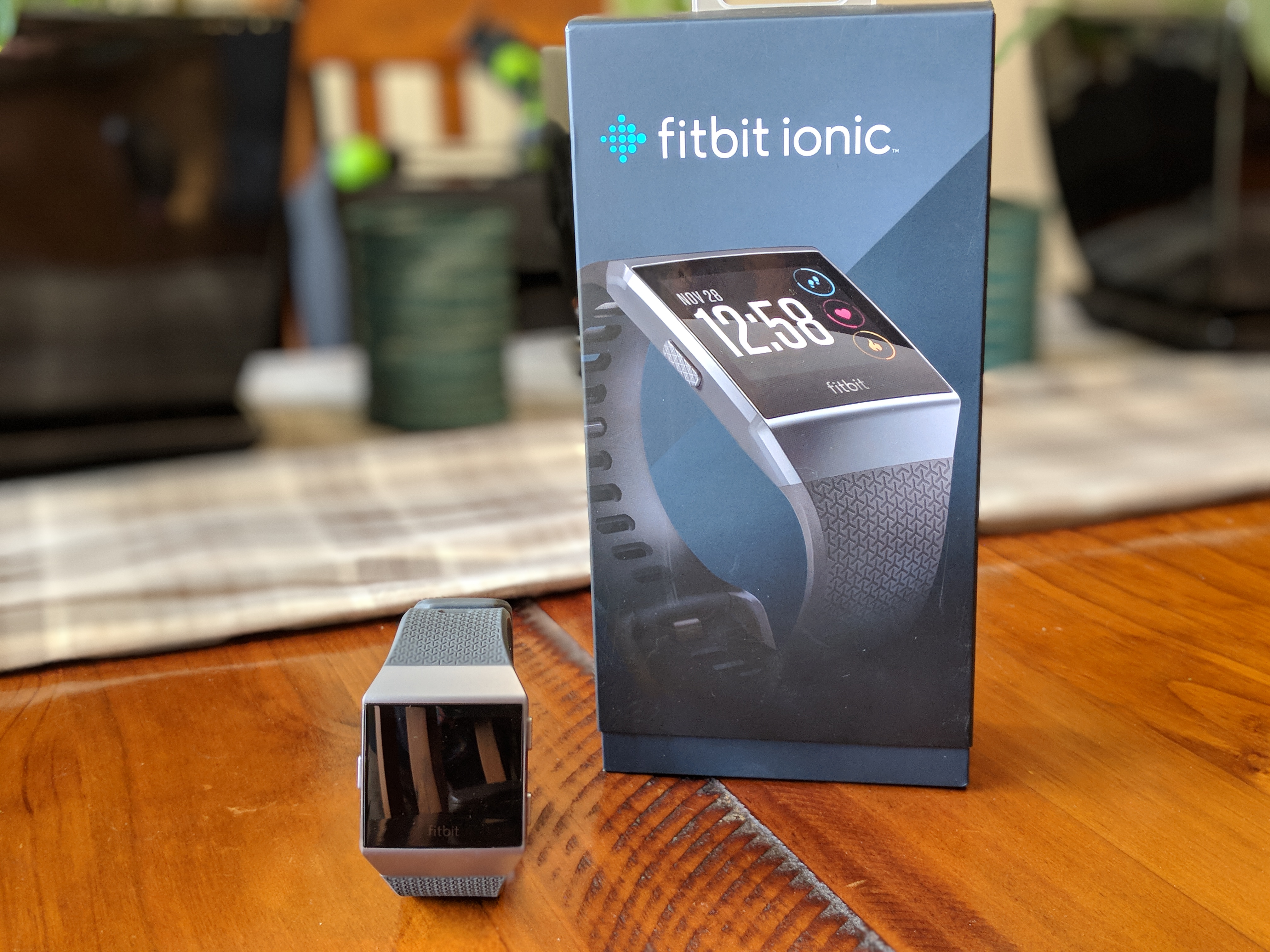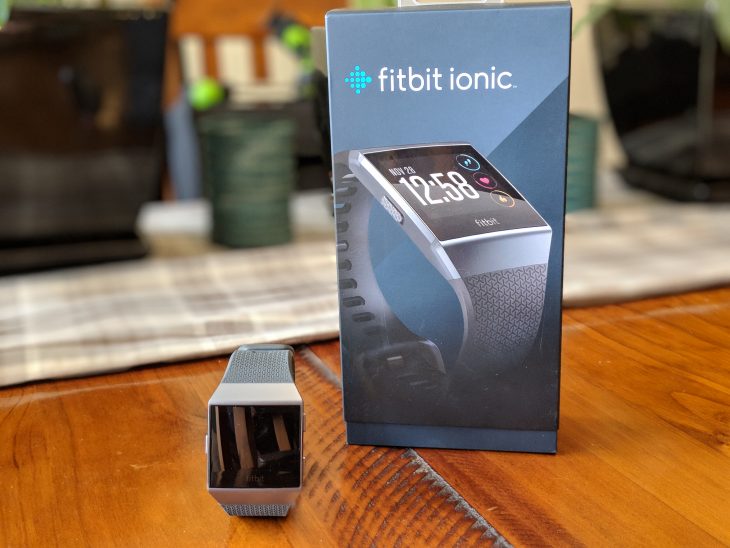 r
r
It’s been a big couple of years for smart fitness trackers with smartwatches now incorporating most of the functions normally included in traditional fitness trackers as standard features in Android Wear, the Apple Watch and others. The biggest name in fitness trackers, Fitbit, is transitioning to smartwatches with the launch of the Fitbit Ionic in a bid to stay ahead of this trend.
The Fitbit Ionic was a pretty loosely held secret, with a few leaks showing what Fitbit had in mind. While they’re at the forefront of fitness trackers, smartwatches is another arena and for once, Fitbit is playing catchup.
The Ionic is priced in the mid-range smartwatch price bracket, taking on the likes of Samsung with the Gear S3, and some mid-range Android Wear devices and of course the newly launched Apple Watch 3.
Does the Fitbit Ionic have what it takes to really take its place in the smartwatch category? Well, to cut a long story short: not yet, but they sure could if they keep at it.
What’s in the box
There’s surprisingly little in the box really. You get the Fitbit, a large and small watch band that have a quick release built-in, a proprietary charging cable and a packet with safety information and a brochure showing the bands and how they attach to the watch.
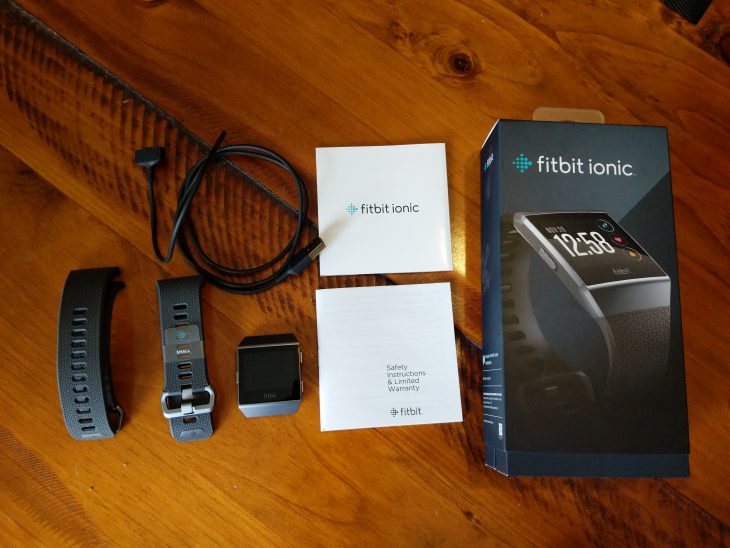
There’s not a real lot extra that needs to be in the box, it’s designed to come out of the box, be fitted to your wrist with either the large or small bands and then used.
Design and Hardware
When the leaks for the Ionic started coming out, the comparison to the Fitbit Blaze was very much there but it’s been refined by Fitbit and I’m happy to say that it’s much better looking in person than it is in the renders released.
Design wise, the Ionix is boxy, but it’s surprisingly good. While most of the smartwatch industry seems to be banking on round watches, Fitbit have staunchly embraced their ‘iconic’ design with the Ionic, it’s not all boxy though it’s got angles where it sweeps in to the lugs which attach the watch band, while the watch face itself has slightly chamfered edges.
The buttons either side of the watch face have a cross-hatched pattern etched in to make them easier to grip when you’re sweating after a workout. There’s three simple buttons, one on the right and two on the left. They’re simple augmentations to the touch interface of the Ionic.
The downside to the design of the Ionic is the proprietary watch bands. It’s a ‘Pro’ in that with the fast clip on the watch bands it’s easy to swap between the large and small bands included in the box, but a ‘Con’ in that it’s not easy to personalise the Ionic with your own preferred watchband.
The bands though are surprisingly comfortable, made of an elastomer material with a surgical stainless steel buckle. The band has a pin on the end that clips the long end of the band to itself after being buckled which ensures it remains secured while you exercise.
There’s a leather and ‘Sports’ band available to purchase from the Fitbit accessory store, the leather which is available in Cognac or Midnight Blue colour options is pretty expensive at $99.95, while the sports band available in Black and Charcoal or Cobalt and Lime is $49.95. I’d prefer standard bands myself as these are quite expensive and I don’t have an issue changing bands on a standard watch, so quick release is a little lost on me.
The face of the Ionic is primarily screen though there are fairly big bezels around the 1.47″ LCD panel. It’s touch sensitive, though you can get through most of the operation with the buttons either side.
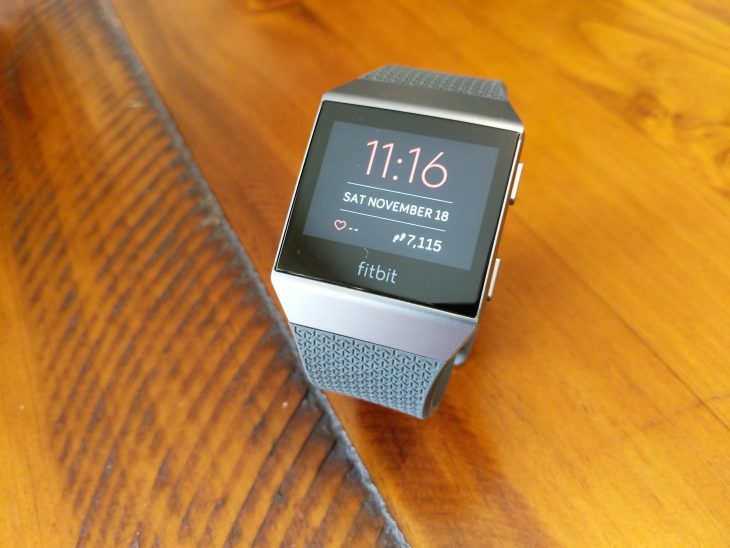
Internally, the Fitbit Ionic has a number of sensors packed into the relatively small body including an altimeter, 3-axis accelerometers, digital compass, GPS, optical heart rate monitor and ambient light sensor. There’s a vibration motor built-in as well to notify you when you need to.
GPS lock is a little slow, but it definitely works well tracking your run, ride, walk or other outdoor activity quite well. The data is synced to the app, and you can see where you’ve been and the drift is pretty minimal. The antenna for the GPS is built into the frame of the watch, possibly the reason for the large bezels around the screen.
The 3-axis accelerometers allow you to automatically track your activites, with the watch picking up when I was on the cross-trainer vs going for a run automatically. It’s a pretty neat bit of tech on that part.
The battery in the Ionic is pretty decent, with a run-time of around 5 days. It drops a little if you do some exercising while tracking using the internal GPS, with Fitbit recommending you charge every few days. I got a solid 7 days out of the watch without using GPS, and around 4 days doing a half-hour run every day, so it’s about on the money. Charging only takes a couple of hours, so it’s not a big deal to keep it topped up.
The included proprietary charger is decent, it magnetically connects quite easily and charges without any prompting. That it’s a proprietary charger is a little annoying, but it is what it is. If you lose it it will cost you $29.95 to replace it from the Fitbit store.
The unit itself is waterproof up to 50 metres so you’ll have no issues sweating through a workout, or showering after. The Fitbit Ionic even has a swim tracking mode so you can use it in the pool with no fear.
Sync from the Ionic to your phone is done through Bluetooth 4.0, with data 7-days worth of detailed (minute-to-minute) data stored on the watch, while you get your daily totals store on the watch for up to 30 days. Syncing daily to the phone, and from there to the cloud is of course recommended, but you can safely go on say a 7-day camping trip or cruise and get your data uploaded the minute you get back without missing a beat.
You can use the in-built Bluetooth to pair some headphones to the watch and play music stored on it without a phone – great when you go for a run, but the process to actually get music or podcasts onto the watch is a bit of a hassle.
There is Wi-Fi and NFC included inside the watch, with NFC used to power Fitbit Pay, while Wi-Fi is used to connect and transfer music.
Fitbit Pay
One surprising feature that launched with the Ionic is Fitbit Pay, an NFC based mobile payments solution.
For a brand new platform, there’s surprisingly three big Australian banks on board: The Commonwealth Bank, NAB and ANZ. While ANZ isn’t a surprise, their history of adopting new platforms is legendary, Commbank and NAB certainly are. Commbank has only just signed onto Android Pay, and NAB hasn’t done so as yet, so adopting a very niche payment system is a complete shock.
The process to setup Fitbit Pay is fairly simple if you have a compatible bank account, as is using it at point of sale. You do have to set a pin on your watch and then get your bank to approve the tokenised setup of Fitbit Pay, but that’s achieved by simply calling the bank as part of the setup process.
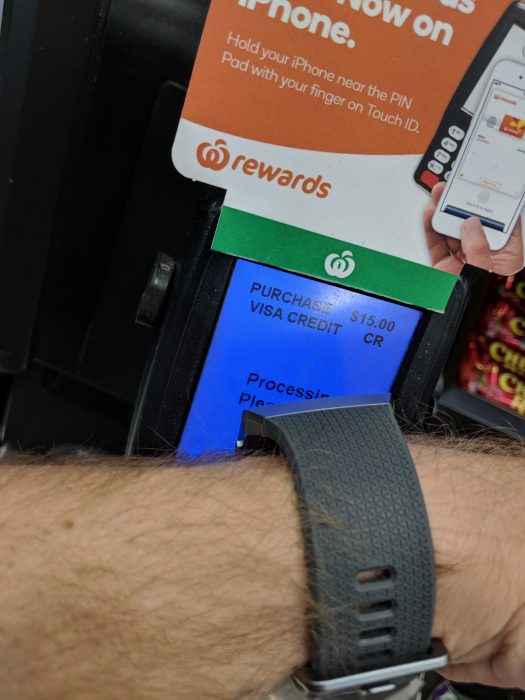
Using Fitbit Pay is a bit more in-depth than just tapping and paying with a card, you have to enter your pin into your watch before you can make a purchase even if it’s under $100. But, it works smoothly so that’s a bonus.
Fitness Tracking
There’s no surprise here that fitness tracking is excellent on the Ionic. The built-in sensors track everything from how many steps you’ve taken, flights of stairs you’ve climbed, your heart rate both at rest and while exercising through to how many calories you burned; Fitbit even uses the sensors for sleep tracking.
The Ionic is fairly accurate too, with a step tracking comparison about on par with devices from Polar (M430), Huawei (Watch 2) and an old Fitbit HR I had laying around about on par.
Heart-rate though could be better. The Ionic uses only a single LED sensor, which I’ve found previously to be unreliable in Android Wear watches. I’d not be inclined to trust it implicitly but it gives you a rough guide when working out. You still get better, more instant results from devices like the Polar M600 with its 6-LED sensor or a bluetooth chest strap, but as a rough guide it’s Ok.
The data from the heart rate monitor is stored at 1 second intervals while you’re working out, but drops to every 5 seconds when not exercising so it’s pretty good at tracking the data.
Smartwatch
Fitbit has made great fitness trackers for years, but the Ionic is their first smartwatch but as a whole, it feels unfinished in terms of the eco-system. In smartwatch terms though, it definitely has something going for it.
Fitbit notably purchased Pebble late last year, and it’s the former Pebble team who have presumably been working on the Fitbit Ionic and the smartwatch. Just as Pebble found though, getting those third party developers on board with a new platform is hard.
The Fitbit app allows you to install additional apps, as well as watch faces onto the Ionic, however there aren’t any additional apps to be found in their app store. The default load out for the watch includes apps for fitness tracking, Music, Coaching, Relaxation, Timer, Wallet, Alarm, Weather and the only third party app available: Strava. Beyond these apps, there’s literally nothing else available.
The actual watch OS itself though has a lot of promise.
Fitbit’s Watch OS has an intuitive interface which is easy to use without any training. There’s the home screen which is ostensibly your watch face, a swipe to the left brings up basic information and settings including how much battery life is left and simple toggles for screen wake and notifications. A swipe to the right lets you access the installed apps on the watch.
Notifications are accessed by swiping up from the watch face. Notifications are a bit of a mixed bag though, they’re really not very useful. You can swipe them away after reading them, or simply scroll down the list to clear them all. There’s no quick reply, nor is there any actions you can take with them. The lack of microphone to dictate a reply to a message would leave you with a
Lastly, you can access your music controls by swiping down, but with music you’ll have to add the music to the watch yourself by connecting the watch to a computer over Wi-Fi and transfer in the songs, or podcasts you want to listen to but even then the instructions are limited to Windows Media or iTunes playlists. There’s an extensive how-to on transferring music in the Ionic user manual you can find online.
The problem with all this is really the lack of apps. There’s a Pandora app for the Ionic, but it’s only available in the US, but there’s also no Google Play Music, no iHeartRadio or Apple Music or any of the popular music services here. There’s a Starbucks app in the US, but again there’s no equivalent app here in Australia.
Fitbit App
The app for Fitbit is very good. I’ve used a variety of apps over the years for fitness devices and they’ve ranged from plain awful through to, well, Fitbit, they’re at the top of their game. It’s fast, responsive and nicely laid out making it easy to navigate.
The pairing of a device is simple, once you setup your account then it’s a matter of getting out there and exercising. The Ionic syncs easily by itself, or you can pull down to force a refresh.
There’s five main tabs in the app, the main dashboard which displays all the relevant information – mainly steps taken. You can see your battery status up the top left next to the Ionic icon. Tapping on the Ionic icon brings you into the Smartwatch settings.
As mentioned above, there’s not a lot to do here with all the apps available for the Ionic installed. There is of course the option to change watch faces, but there’s not many of those available either. This is also where you setup your Fitbit Pay, and you can set your notifications and other settings on the smartwatch.
The dashboard though is your default screen you load into, it’s where you see your various metrics for floors climbed, distance travelled, calories burned and minutes spent exercising displayed below. Tapping on each brings up more information, including a history for the week.
Further down you see your Goals met, information about your sleep, heart rate and then information about your food and water intake (if you log them) and if you have an Aria scale it shows you your weight stats. Logging food was a pretty average affair, I spent the majority of my time adding food to the database before giving up and going back to MyFitness Pal.
The remaining tabs include challenges, guidance, friends and your account.
Challenges shows various things you can do with your Fitbit friends, allowing you to virtually walk through trails or runs around the world – frankly, a bit over-rated for me.
Guidance is where you head to check in on the Fitbit coach, I probably should head in here more often but I’ve been off to the gym myself for so long I’m in a routine. Still, it’s there if you’re looking for some more expert assistance.
Friends is where you can check your progress against other friends who are in the Fitbit eco-system. You can message friends with encouragement (or derision when you beat them). It’s supposed to challenge you a bit, but I’m not terribly into that sort of competition.
The account tab is where you’ll find all the bits and pieces about your account. You can find all your compatible devices here, as well as change your goals, modify the settings on your device (location, time zones, etc.).
Conclusion – Should you buy the Ionic?
Lack of apps is the biggest killer for the Ionic for me at least. It has promise though, with a more robust app catalogue it’s got a bright future as it’s quite a smooth device to navigate and use. Fitbit’s health and fitness hardware and software are top-notch as we’ve come to expect, it’s just the smartwatch side that needs some more work.
The bonus of being a smartwatch is that Fitbit can fix a lot of the issues with software updates and by courting developers and releasing apps. Until then, it’s a marvellous fitness tracker, with some decent smart functions built-in.
In the end, there’s plenty of cheaper Fitbit products out there that will fill the role of fitness tracker, but the future for the Fitbit smartwatch eco-system is definitely promising.

